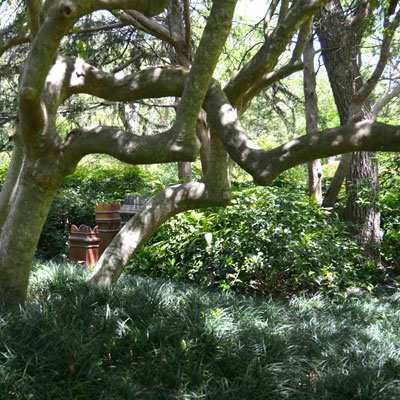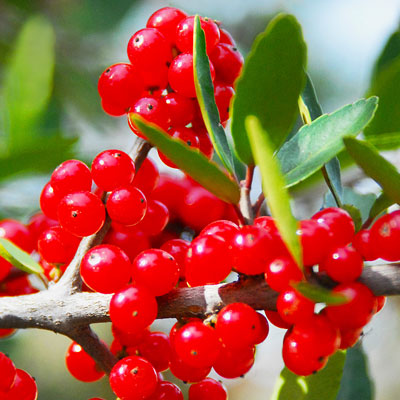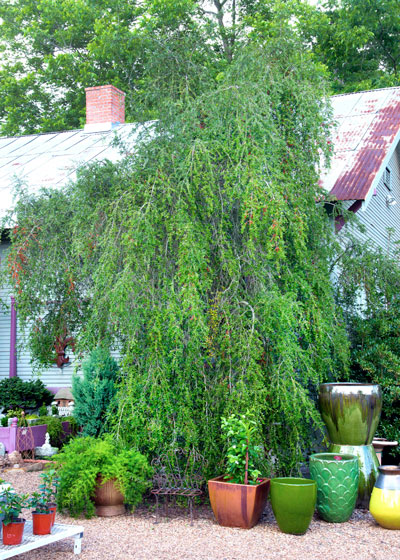Yaupon Holly is Texas’ Star Native Shrub
No shrub that grows wild in the Lone Star State is any better suited to our landscapes and gardens than this great holly. And yes, it definitely is a shrub, even though we see it used most commonly as a small accenting tree.

This is the best landscape plant I’ve ever bought (in terms of its price). And that was 35 years ago. Normally a shrub in nature, yaupon holly can be trained to grow as a small tree.
Here are the facts in quick form…
• Ilex vomitoria It gets that species name from the fact that it can make animals that feed on its berries ill. You get the picture.
• Native range: eastern quarter of Texas, primarily in the areas where post oaks grow natively (along and east of I-45).
• Mature size: to 20 ft. tall and wide, but can grow larger in exceptional conditions.

Remember that yaupons are shrubs by their nature. These massive branches become graphic examples of that as we train the plants as trees and as the trees age. This is the same tree you see in the photo above.
• Growth form: in nature all yaupons are shrubs. Lower branches can be removed and plants can be trained to grow as small trees.
• Soil preference: tolerant of all types, but grows best in neutral or slightly acidic and moist soil.
• Sun/shade: tolerant of both.
• Leaves: evergreen, fingernail-sized, no spines, but rounded teeth along edges.

Yaupon holly’s berries are some of the smallest of all the hollies, but the plants make up for it in quantity. It doesn’t get much prettier than this when it comes to wintertime color.
• Fruit: BB-sized bright red berries that mature in winter and remain attached to plants until cedar waxwings and other migrating birds feed on them in early spring.
• Gender of plants: male and female plants are separate, so if you want fruit you must buy a female plant and there must be a male plant somewhere nearby. (Pollinated by bees.) If the plant you’re looking at has one or more berries (even if they’re green), it’s a female plant. There are several outstanding named varieties of standard yaupon hollies, all female.
• Best time to plant: doesn’t matter if you’re buying a plant that’s been grown in a container. If you are digging and transplanting, winter is the only acceptable time.
• Pest problems: none.
Selections you will find in nurseries…
• Dwarf yaupon. There are many selections that grow to be 3 ft. tall and wide. They’re great small, light-textured shrubs for sun or shade. They can take annual shearing in early February to keep them more compact.

Dwarf yaupon is one of my favorite plants in the Sperry landscape.
• Weeping yaupon. This is a decidedly weeping plant. It would appear to be light and airy in texture, but in reality it makes a very bold plant in the landscape. Handsome and dramatic. Give it plenty of room.

You can see how dramatic weeping yaupon is in the landscape. I took this photo at Blue Moon Gardens in Chandler (between Edom and Tyler) a couple of years ago. This is a spectacular example.
• Will Fleming and Scarlet’s Peak. These are both columnar forms. Will Fleming has been around for 25 years. Its branches tend to splay out as the plant grows (not good). Scarlet’s Peak is a newer introduction that seems to have stronger stems. However, it’s not as commonly seen yet. You may have to ask for it when you go shopping.
• Yellow-berried regular yaupon. You may or may not find this one, but if you do, you might want to take a pass on it. I was really excited to buy one. I have it growing along our driveway, and the first year that it bore a heavy crop of fruit I could hardy wait for it to change colors. One week, after a trip out of town, I returned to find the older, lower leaves on my yaupon had turned a golden yellow. As I got closer I realized it wasn’t leaves, those were the berries. They’re just not as showy as the red fruit. Not even close.
